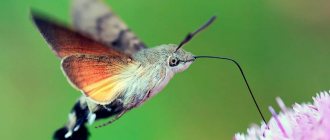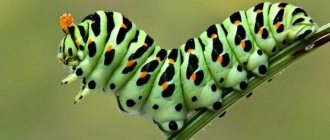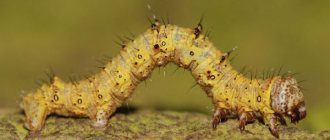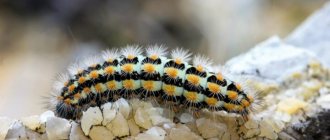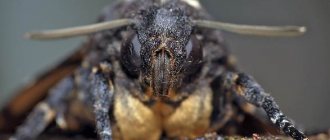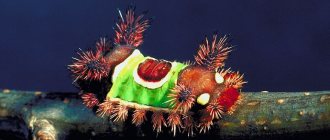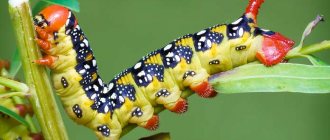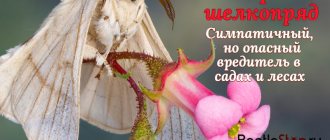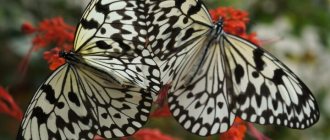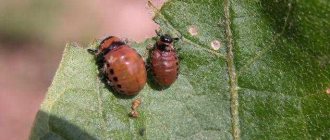- Wild animals
- >>
- Insects
The hawk moth butterfly is a very bright, extraordinary representative of lepidopteran insects.
It can often be found under the name hummingbird. This name is due to its bright color and feeding habits. The butterfly is distinguished by its medium size and the presence of a special proboscis, thanks to which it does not sit on the flower itself, but flutters and soars around it, collecting sweet nectar. Today the butterfly is a rather rare insect. Despite the fact that the caterpillars of these butterflies are quite voracious, it is not recommended to use chemical insecticides to combat them.
Butterfly hawk moth: description
The hawk moth is considered a rather interesting and amazing insect, resembling hummingbirds in appearance.
Different species of these insects are active at different times of the day: some fly during the day, others in the evening, after sunset, and others even at night. At the same time, you can see insects with very original body colors, so many owners cannot determine what kind of species it is. Nature of life:
- Adults grow up to 11 cm in length and have a proboscis up to 10 cm in length. The wingspan of the butterfly is 65-120 mm.
- The insect is capable of flying at speeds of up to 50 km/h.
- The hawkmoth butterfly flies over flowers, hovers over them and feeds on the nectar of flowers.
- The complete development cycle of such an amazing creature consists of 4 stages: a caterpillar (larva) appears from the egg, which after a certain time turns into a pupa, and an adult flies out of the pupa and lays eggs. This lasts from 30 to 45 days, so over the summer 2 generations of these amazing creatures are born.
- Adults emerge at the end of June and perfectly complement the greenery with their outfits. They begin to fly around flowering trees and shrubs, such as apple, pear, lilac, chestnut, pollinating them.
- The larvae of the hummingbird butterfly are quite large and can reach a length of about 12.5 cm. At the same time, they are distinguished by the original, bright pattern of their body. Some species have a fantastic range of colors: green with a lemon tint, white with black and yellow spots, brownish-gray with “painted” eyes on the front of the body. As a rule, they look like creatures, as if from another planet.
- A characteristic feature of the hawk moth caterpillar is the presence of a horn at the end of the body. The color of the horn depends on the type of butterfly and may have original colors.
- Before turning into a butterfly, becoming a pupa, the caterpillar changes its color. Before becoming a pupa, the caterpillar has already accumulated the required amount of nutrients and hides in the ground. After 18 days, a rather beautiful hawkmoth butterfly emerges from the pupa. As soon as the wings dry, the butterfly takes flight to find a sexual partner and lay eggs to prolong its kind.
Additional factors:
- If you take a hawk moth caterpillar, it does not cause disgust and behaves quite calmly or moves slowly. Many people are afraid of caterpillars, but this caterpillar does not bite and cannot harm humans.
- The caterpillars feed on young leaves. The wine hawk moth prefers to settle on the grapevine. The caterpillar is large in size and has a very warlike coloring, with a spike at the end. The caterpillar has a rather unusual appearance, so many owners do not try to destroy it, constantly watching it. After some time, I manage to see a beautiful butterfly.
- The tongue hawk moth is similar in appearance to a small bird. It can often be seen in the garden, and children who have seen this creature say that they saw a small, unusual bird in the flower garden.
- The death's head hawk moth is distinguished by the fact that it has a pattern on its chest similar to a skull or a design that was found on pirate flags. This is one of the largest butterflies of the hawkmoth species. It feeds on both the sap of young trees and honey. This butterfly can easily climb right into the hive, making sounds like a young queen makes sounds. Therefore, she calmly steals honey from the bees. They do not touch her, as they mistake her for one of their relatives.
- Bedstraw hawk moth is more common in the middle zone. It has a long proboscis and a dense body. At the same time, the body color is a combination of brown and beige, and orange splashes are visible on the tips of the wings.
These insects are also called sphinxes. This is due to the fact that the disturbed caterpillar raises the front part of its body and freezes in a sphinx pose.
There are several types of hawk moths:
- Euphorbia.
- Wine.
- Pine.
- Dead Head.
- Ocellated.
- Oleander.
- Convolvulus.
- Lilac.
- Proboscis Hawkmoth and many others.
Interesting to know! Scientists know about more than 1000 species of these insects. There are species that constantly migrate, making long-distance flights, as well as flying from continent to continent.
Butterfly “hummingbird” – Hawk Moth. Watch this video on YouTube
Medium Wine Hawkmoth / Deilephila elpenor Linnaeus
- Size: 20-25 mm;
- Forage plant: bedstraw, less often fireweed (fireweed)
- Collection of caterpillars: second half of summer;
The wine hawk moth caterpillar makes an impressive impression: it is as thick as a finger, 7-8 cm long. In case of danger, the caterpillar compresses its thoracic segments and retracts its head, showing “eyes” - bright ocellated spots on the first abdominal segments located on the dorsal side. On the last segment of the body there is a horn - an indispensable accessory of most hawkmoth caterpillars. The color of the caterpillar of the average wine hawk moth is brown in all shades: from almost black to coffee with a black streaky pattern. Shades depend on age and individual characteristics. Sometimes there are larvae of a soft green color with a black pattern. These are found in nature in less illuminated places, where the leaves of fireweed (the main food plant) are pale green in color and there are almost no dry leaves. With home breeding, the percentage of green caterpillars increases. The color of the caterpillar does not affect the color of the butterfly.
In nature, many caterpillars can be infected with tahini fly larvae. In this case, light scars are visible on the velvety skin of the caterpillar or it seems as if it is pulled together in several places. Obviously, infected caterpillars are not suitable for breeding.
The main forage plants are fireweed (fireweed) and bedstraw.
Fireweed stems stand well in water; it is best to cut them from well-lit places. It is best to cut when there is dew (in the morning), wrap the cut siebli in a wet cloth, and when you get home, put it in water and place it in an aquarium or cover it with plastic bags, after spraying it with water. At the same time, to reduce moisture evaporation, the tops of the shoots should be cut off.
Fireweed: Bedstraw:
The caterpillars of the common hawkmoth pupate in the ground and, as a rule, burrow shallowly. Some butterflies emerge during this season, so it is recommended to leave supports in the aquarium for pupation.
Mating does not occur immediately after the butterfly emerges from the pupa. The female, ready for breeding, is heavier; during flight, she makes a loud and distinct hum. Mating lasts from 15 minutes to 3 hours and usually occurs at night. Egg laying occurs soon after mating.
The eggs of the wine hawk moth are small, their development lasts on average 6-10 days, depending on the temperature. Immediately after laying, the eggs are light green in color; gradually they become yellowish-green. After 2-3 days, developing eggs can be easily distinguished from unfertilized ones: their color is uneven, and bubbles appear under the shell or the shell seems to sags. If the shell has sagged so much that the egg is shaped like a cup, then it is dead: either it remains unfertilized or has dried out.
“Butterflies for home breeding”, first published on the forum about pets “ZOOblog”
Description of the species
Wine hawk moth belongs to the genus Deilephila. These are large and medium-sized butterflies with a wingspan of 40-80 mm. Representatives of the species are divided into three groups based on size.
Deilephilaporcellus
Lesser wine hawk moth is widespread in the Palearctic. The wingspan of the moth is 40-55 mm. The body is pink, the front wings are yellow-olive with wide pink margins along the edge. The hind wings are pink with an ocher band. Flies in May-August. The larva is dark brown with black shading; there is no horn. Often found in southern Russia, does not migrate.
Interesting fact. As a defense mechanism, caterpillars can relax their muscles to simulate death.
Deilephilaelpenor
Medium Wine Hawkmoth is an olive butterfly with a pink pattern. The base of the hind wings is black. Wingspan 50-70 mm. The head, chest and abdomen of the moth are olive green. The pinkish stripes on the back in the abdominal area merge into one longitudinal line. The antennae are thickened, grayish-pink. The eyes are large, complex, covered with scales. Insects have excellent vision; they see objects in low light.
Information. Hawkmoths fly at speeds of up to 50 km/h. The wind interferes with their flight and while feeding on flowers. When the wind force is 3 m/s, insects do not fly out to feed.
Insects are common in Europe, including the south of the Urals. Found in Turkey, Iran, Central Asia, India, Korea, Japan and China. It lives in gardens, at the edge of the forest, and on roadsides. Settles on honeysuckle bushes, petunias and iris flowers. Moths living in gardens and parks pollinate 5-10% of nearby trees and shrubs.
Attention. Medium wine hawk moth is listed in the Red Book of Karelia and the Belgorod Region as a rare species.
The wine hawk moth caterpillar can be green or dark brown, almost black in color. On the 4th-5th body segment there are round black eyes with a white border. The tail horn is short, black at the base, and the tip is white. Due to their large size (70-80 mm), the caterpillars make a terrifying impression on people. They are actually not dangerous. The larvae do not even cause serious harm to plants.
In case of danger, the wine hawk moth caterpillar is capable of inflating a segment of the body that has eyes. She draws her head in and assumes a sphinx pose, lifting her front legs off the surface. At the same time, she becomes like a snake. Given the impressive size of the body, enemies such as birds prefer not to engage in combat.
Hippotioncelerio
The largest representative of the species reaches sizes of 70-80 mm. The color of the elongated body and wings is olive-brown. A gray-blue longitudinal line is noticeable along the entire body from the head to the end of the abdomen. The wings have patterns of dark strokes and wide light stripes. Caterpillars grow up to 90 mm. The color is green or brown, there are light dots on the sides and a longitudinal white stripe. The horn is long, straight, and brown at the end. On the first segment of the chest there is a black eyespot, on the second - white. What does the wine hawk moth caterpillar eat? The tropical species is not original in its choice of diet; its larvae live on bedstraw, lilac, bindweed and other plants. The butterfly is common in warm countries - Africa, Central and South Asia. It migrates to the south of Europe in the summer season, flying vast distances, and does not winter. At home it produces up to five generations per year.
The most beautiful caterpillar in the world
Since we have already examined the most poisonous caterpillar in the world, we would now like to contrast it with the most beautiful and harmless one - the monarch larva. It is worth saying that even the name of this large caterpillar with a horn speaks for itself. A truly royal creature immediately appears, enchanting with its beauty and pleasing to the eye. Its main color is white and, if not for the bright yellow stripes on its back, the caterpillar would look like a zebra, because it is also completely covered with black thin stripes. She has three pairs of horns: two on her head, two on her tail and the same number in the middle of her body. They are located symmetrically to each other.
The monarch butterfly is one of the most famous butterflies in North America. It is easily recognized by the characteristic pattern on its wings: black stripes located on a red background. The wingspan of the Danaid reaches 10.2 cm. This is one of the few insects that flies across the Atlantic Ocean during migration. In Russia, the species is found in the Far East.
What types of hawk moths are there?
There is a huge variety of moths in this group. It will be very convenient to consider the hawk moth family in the table.
Species namesDescription of wings
| Hawk hawk | The upper ones are red in color with brown spots. There are bright blue “eyes” on the lower wings. |
| Hawkmoth is blind | On the lower tier there are bright spots imitating the eyes of animals. |
| Lesser oleander hawkmoth | It has green upper wings with a dark spot. The lower wings are bright orange with a pronounced border. |
| Brazhnik Tatarinov | The green upper wings are complemented by red-gray lower wings. |
| Euphorbia hawk moth | Green upper wings with a light stripe in the center and spots. The lower ones are black with a pink border. |
| Ademarius of Darius | The wings of the upper tier are discreet, helping to hide. The lower ones are pink with black trim. |
| Hawkmoth common tongue | Large wings are gray with stripes. Small ones are bright orange. |
| Lilac Hawkmoth | The upper ones are brown, and the lower ones are pinkish with clearly defined black transverse stripes. |
| Hawkmoth anthea | This butterfly has yellow wings with transparent “windows”. The body, or rather its sides, is also covered with yellow hairs. |
| Hawkmoth Megaera | Large wings are green, small wings are yellow. |
| Aspen Hawkmoth | Both large and small wings are lilac in color. |
| Pine Hawkmoth | Large wings are gray and inconspicuous. Small ones of the same color. At the same time, there are stripes on the body that form a clear square. |
| Pink Hawkmoth | The body and wings of the insect are yellow-pink, but the antennae are pure white. |
An inhabitant of Russian latitudes, who is often mistaken for an alien
Of course, at the very beginning I would like to talk about those types of large green caterpillars with horns that live in our country. The most common larva of the hawk moth and all its subspecies. For example, linden hawk moth. Its larva is a fairly long caterpillar. Sometimes it reaches 10 cm in length. Its color, unlike other caterpillars with horns, is quite calm and not particularly attractive. Most often, this insect is light beige or light brown in color with a white abdomen, on which there are horny growths, which are nothing more than the rudiments of the insect’s legs. They are quite hard and tenacious to the touch; thanks to these properties, the caterpillar can easily move along tree trunks. In rare cases, linden hawk moth larvae can be bright green or black with brown speckles. No matter what color the caterpillars are, they always have a sharp, hard spike on their tail, which many take for a horn, confusing the insect’s head with its tail.
Habitat
Hawk moth is a heat-loving butterfly, so the vast majority of species can be found in regions with a tropical climate and dense vegetation. Butterflies similar to hummingbirds live in Africa, North and South America, Eurasia, and Australia. Many species actively move around the world. Hawkmoths are capable of covering enormous distances, flying across seas and mountains over 3.5 km high.
With the onset of summer, many species migrate to more northern areas, where they leave their offspring. Hawkmoths can also fly away from overpopulated areas in search of new territories.
The hoary caterpillar is a beauty that you should not touch
The most poisonous caterpillar in the world is simply extraordinarily beautiful: a brown head with pronounced light green “glasses” and body, and on its back a brown diamond shape reminiscent of a horse’s saddle. Of course, thanks to this attribute, this larva is called saddleback. On the head and tail of the poisonous caterpillar there are two impressive horns, completely covered with sharp spines. It is they who pose a huge danger to everyone who decides to touch an unearthly creature that enchants the eye. By the way, if you look at the hoary caterpillar from above, it is impossible to make out where its head is and where its tail is, since the poisonous insect looks absolutely symmetrical.
This miracle of nature lives in North America; it can be found mainly on deciduous trees. Just like the other caterpillars with a horn on their tail discussed above, this species contains poison in its appendage. However, if nothing happens when you touch the hawk moth, then when you touch the poisonous caterpillar, a person will feel discomfort, as if he had been stung by a bee. The consequences can be unpleasant: nausea, vomiting, headache and rash at the site of contact. Symptoms last up to two days.
Reproduction and lifespan
Basically, a butterfly manages to produce offspring twice. If there is a long warm autumn, this may happen a third time. True, when it gets cold, the offspring from the third brood in most cases die from a sharp change in temperature.
Hawkmoth caterpillar
There are 4 phases in the life cycle of Hawkmoth butterflies. Initially, a sexually mature female lays an egg. Hawk Moth caterpillar) emerges over time . The larva eventually turns into a pupa, which becomes an adult butterfly.
In order for a male to mate with a female, she secretes a special pheromone that attracts a gentleman. Mating takes several hours. After which the female lays her eggs on the plants. There may be about a thousand of them. Most often, Hawkmoth eggs can be seen on nightshade plants, potatoes, and tobacco.
The appearance of larvae is noticed on days 2-4. Larvae need a lot of food to survive normally. Therefore, they actively absorb it in the evening and at night. The larva grows to large sizes, its length can reach 15 cm.
Hawkmoth oleander
Her whole appearance may be threatening, but in fact she is a painfully harmless creature who spends most of her time underground and appears on the surface of the earth only if she needs to refresh herself. The pupa has to survive the winter in the ground. At the same time, she does not wrap herself in a cocoon. With the arrival of spring, a real Hawk Moth butterfly emerges from such a pupa.
What are the dangers of coronavirus vaccination?
What we know about COVID-19?
This is an RNA virus of animal origin belonging to the group of coronaviruses. According to WHO, it is transmitted from a sick person through small droplets that are released from the nose and mouth when sneezing and coughing. From the moment of infection until the appearance of the first symptoms, it takes from 1 to 14 days (on average - 7). The carrier of the virus does not yet know about his illness, but in terms of infection he already poses a danger to others. According to coronavirus epidemiology, COVID-19 is 2-3 times more contagious than the flu, but 2-3 times less contagious than measles.
With a mild course of the disease, its symptoms are similar to ARVI and end with recovery after 14 days without any further consequences. In severe cases, COVID lasts up to 8 weeks. Even in the absence of pronounced signs of the disease, immunity is formed in those who have recovered from the disease. But given the infrequent cases of re-infection, it does not last too long. The vaccine has a much greater effect.
How does the vaccine work?
Today, several immunodrugs are used in the world, developed by specialists from different countries and having passed the necessary clinical trials. All of them are designed to form immunity to the pathogen. After their administration, the immune system:
A person who has been vaccinated develops lasting immunity to COVID.
Is vaccination dangerous?
Each person reacts to the immunodrug individually. Therefore, even the best quality vaccine can cause side effects. Their appearance for a short time is the only danger.
Why is vaccination against coronavirus dangerous?
These unpleasant symptoms disappear within a few days.
Severe conditions after administration of an immunodrug can develop in people who have contraindications. Vaccination should not be carried out if:
In these pathologies, vaccination can provoke an exacerbation.
Also contraindicated are age (under 18 and over 65 years), pregnancy, or recent severe form of coronavirus infection. People who have been ill have a high level of antibodies during the first time after recovery, and the vaccine will increase it even more. The consequences may manifest as a violent immune reaction in the form of a cytokine storm.
How to reduce negative manifestations?
Following all doctor’s recommendations will help reduce the development of side effects. To reduce the risk of developing negative symptoms after vaccination, you need to:
In the absence of contraindications and compliance with all requirements, the risk of side effects is minimized.
After vaccination against coronavirus, doctors advise following a gentle regimen and drinking at least 1.5 liters of fluid per day. When the temperature rises, it is recommended to take an antipyretic drug. If weakness does not go away within a few days, or allergic reactions occur, you should immediately consult a doctor.
When will there be mass vaccination?
Mass vaccination in the USA, Canada and European countries began in December last year. At the same time, it started in Russia. But at the initial stage, the event was held only for a certain category of people - young people and those who, due to the nature of their professional activities, cannot limit the number of contacts. Today you can get vaccinated against Covid in any region of the country.
Source
Hawk Moth Life Cycle
The development cycle of the hawk moth is no different from the development cycle of other butterflies and includes 4 stages:
- egg - embryo develops from 5 to 10 days;
- larva (caterpillar) – grows from 15 to 45 days;
- pupa – development period from 10 – 30 days to 2-3 years;
- adult.
A female ready to mate produces pheromones that attract males. A day after mating, the butterfly begins to lay eggs. The female lays from 5 to 30 eggs per day.
Depending on climatic and weather conditions, as well as the length of daylight hours, from 1 to 3 generations of the butterfly grow per year. The first adults appear at the end of May, and the third generation, under favorable conditions, hatches at the end of September - beginning of October.
Life is short
If we consider the species of butterflies in general, then among them there are no ones that would live longer than two or three weeks. Those that can last a month are already real long-lived insects.
Some of the representatives of hawk moths are lucky enough to enjoy life for just a few days. Now we are talking about those that have neither a proboscis nor a digestive system. Such butterflies live only on the substances that the caterpillar has accumulated at one time.
Hummingbird butterflies, capable of obtaining food from flowering plants, delight us with their presence a little longer - up to a month.
Sometimes two generations of hawk moths are born a year - in May and September.
What do caterpillars look like?
The hawk moth caterpillar can be identified even without a photo. These are large, often very bright larvae. Covered with very little hair. The presence of a horn is characteristic, but not all species have it. The color can be pink, white, black, green. There may be oblique stripes and “eyes”.
The hawk moth has quite large caterpillars
There are also differences between each type of hawkmoth:
- The wine hawk moth caterpillar has a pair of large “eyes”; the larva is able to bend, lift the part of the body with the “eyes” and inflate it, which makes the spots even more frightening.
- The triangularis caterpillar is covered with yellow hairs. The larvae's legs have a pattern that makes them look like a reptile's eye.
- The larva of the poplar hawkmoth is green, with a yellow pattern and oblique stripes.
- The lilac in its larval stage is also bright green with pink stripes. In the absence of movement, it resembles a plant leaf, while the horn imitates the stem of the leaf.
- The Euphorbia Hawkmoth caterpillar has black rings on a yellow background. But the legs and head are bright red.
- The larva of the bedstraw hawkmoth is almost black, with yellow spots on the sides of the larva.
Incredible species of caterpillars that exist side by side with humans
Today I would like to talk about an insect larva, which subsequently turns into a beautiful creature - a butterfly, at least this is written about in all the encyclopedias about wildlife and the world around us. So, we will talk about caterpillars with horns and their features, which, judging by the name, should not be so few. Looking ahead, I would like to note that such caterpillars are characteristic of many species and they even pose a certain danger to smaller insects, and some to humans. But be that as it may, such representatives of the flora cause only delight in those who look at them, because they are incredibly beautiful and divinely beautiful.
Nutrition
The main food of butterflies is nectar, which contains a large amount of carbohydrates. This is practically the only thing that an adult hawk moth eats. First it circles over the flower, then it hovers, lowers its proboscis and begins to drink. But some species stand out for their food preferences. For example, the Death's Head hawk moth prefers to steal honey from beehives.
Caterpillars feed mainly on young leaves, like butterflies, preferring certain plants, which in many cases give the name to the species, for example, lilac, poplar, sea buckthorn, euphorbia.
Features and lifestyle
In addition to the feeding habits of the butterfly hovering over flowers, there are other interesting details of its lifestyle. Here are some of them:
- Hawkmoths are mostly crepuscular or nocturnal, but there are also those who are active in the early morning;
- before turning into a pupa, the caterpillars sink into the ground;
- Hawkmoths fly very quickly, reaching speeds of up to 50 km/h, and they fly with a characteristic low sound, reminiscent of a buzz;
- some butterflies, when frightened, emit a loud, unpleasant squeak;
- Because of their long proboscis, hawk moths are called butterfly elephants.
Hawkmoths can very rarely be found in the garden, but in the garden above the flowers they appear much more often.
Are hawk moths useful?
Like any insect, it pollinates the plant. At the same time, they do not cross them, but collect nectar only from similar plants. The caterpillars feed on leaves, but they do not eat much and cannot cause any significant harm. But there are exceptions. The tobacco hawk moth is very voracious, as is its caterpillar.
When growing tobacco and tomatoes, chemicals are used to get rid of tobacco hawk moth caterpillars.
But not only in nature, butterflies can be beneficial. Due to their large size, the larvae are used in neurobiology. In addition, they can be easily bred to provide nutritious food for reptiles.
In this video you will see how the hawk moth feeds on pollen:
What attracts beautiful butterflies
These unique creatures are attracted to beautiful flowers in the garden, the fragrant nectar of which is included in the diet of hawk moths. The more different flowers, ornamental shrubs and fruit crops there are on the site, the higher the likelihood of these insects appearing. The wine hawk moth settles where grapes are grown.
Hawkmoth caterpillars eat the leaves of many cultivated plants, but they do not cause significant damage to these plants.
Enemies of butterflies
In nature, hawk moths have quite a lot of enemies. Among them:
- birds;
- amphibians (frogs, toads);
- spiders;
- predatory insects (ants, mantises, beetles, dragonflies, wasps);
- reptiles (turtles, lizards);
- bats (bats, fruit bats);
- mammals.
The most dangerous are bats and fruit bats, as they hunt at night, that is, when most species of hawk moths are active. Eggs, larvae and pupae suffer the most, as they are immobile. In order to avoid extinction of the species, butterflies have to lay many eggs to ensure the appearance of a sufficient number of offspring.
Hawkmoths in the wild
Beautiful and unusual hawk moths often become food for many other animals. They attract:
- birds;
- spiders;
- lizards;
- turtles;
- frogs;
- praying mantis;
- ants;
- Zhukov;
- mice.
Most often, pupae and eggs suffer only because they are immobile.
But caterpillars can suffer from:
- parasitic fungi;
- viruses;
- bacteria;
- parasites.
Is it worth fighting the hawkmoth butterfly?
The hawkmoth butterfly rarely appears in the garden, as it is more attracted to flower beds and flower beds. These insects are also plant pollinators, so we can safely talk about the benefits of these insects. There is no serious harm from the caterpillars of these butterflies: although they eat young leaves, but not on a huge scale. The plants have time to recover.
It is not often that you see a cluster of hawkmoth butterflies, as they are a rare insect. For this reason, beautiful caterpillars should not be destroyed. It is better to take them and take them to the meadow or to the nearest plantings.
Few summer residents have information about these large caterpillars, but when they find out what kind of species they are, they continue to monitor their vital activity. Quite often they film the caterpillars and post them on the Internet.
Therefore, despite the menacing appearance of some caterpillars, they are absolutely safe. Although they eat the leaves of some cultivated plants, such caterpillars appear quite rarely in the garden or garden, and they are not capable of causing significant harm. Before deciding on their destruction, it is better to find out what kind of insect this is, especially since it has a very original appearance.
Since the hawk moth butterfly is listed in the Red Book, seeing it in your garden or garden is a great success for the owner. The task of everyone is to preserve rare species of insects for our descendants. If one caterpillar appears in a garden or vegetable garden, it will not be able to harm or in any way affect the development and growth of plants. Having seen such a miracle of nature, it is better to protect it by moving it to other plants, for example, to a flower bed, where it can be safe.
Honey thieves
Hawkmoths do not live on nectar alone; they also have great respect for honey. Butterflies do not hesitate to climb into beehives for this delicacy. And what’s most amazing is to return from there not only alive and healthy, but also well-fed. How do bees tolerate such brazen attacks?
Entomological scientists have come to the conclusion that the quiet creaking sounds that hawk moths make have a hypnotic effect on the entire swarm, reminding bees of the sound of the queen
This is how the butterfly distracts the attention of the bees and feasts on honey
Hawkmoths should not be destroyed for this cute theft, they do not harm the apiary, and it would not hurt to protect honey thieves: almost all species of these butterflies are listed in the Red Book.
Butterflies are one of the most beautiful representatives of the fauna. Moths from the hawkmoth family feed on nectar; they flutter over flowers like hummingbirds. Observing the amazing creatures of nature brings real pleasure to naturalists. Unfortunately, the number of hawk moths is constantly declining; many species are listed in the Red Book. The thoughtless destruction of insects, the use of pesticides and the destruction of the natural environment make them rare guests on Russian territory. Wine hawk moth with a delicate olive-pink color is found in the central zone of the country. To change people's attitudes towards these insects, we need to learn more about their lifestyle.
Is it possible to breed butterflies at home?
In order for the hawkmoth butterfly to live at home, you need to provide it with a temperature of + 22 degrees, and the duration of daylight is at least 14 hours. An insectarium is used for breeding. You need to spray the container regularly to increase humidity. The caterpillars should have a bowl or box; it is recommended to cover its walls with mesh so that the larvae can crawl along it. The container cannot be tightly closed; there must be ventilation.
During the pupal stage, it is necessary to ensure sufficient soil thickness. This could be peat or moss. The soil should always be moist, but not wet. You can feed with water with added honey. Plants are also used if caterpillars are present.
The container with water must be covered, otherwise the larvae may fall from it and drown.
It is especially beneficial to place flowering plants in a large container. Then the food will be natural. If you comply with the growing requirements, you can observe all stages of hawk moth development.
Black always goes with white - a rule that even nature follows
Probably, many have heard about the next caterpillar with horns, but not everyone has seen such an incredible beauty created by nature. We are talking about a swallowtail larva. The adult is bright yellow with four eye-shaped round black spots on the wings. Who would have thought that, being a caterpillar, the swallowtail is not bright. On the contrary, the larva is completely black with horns of the same color located throughout its body. However, in the later stages of caterpillar development, just before pupation, the black color of the body is diluted by numerous contrasting white spots.


